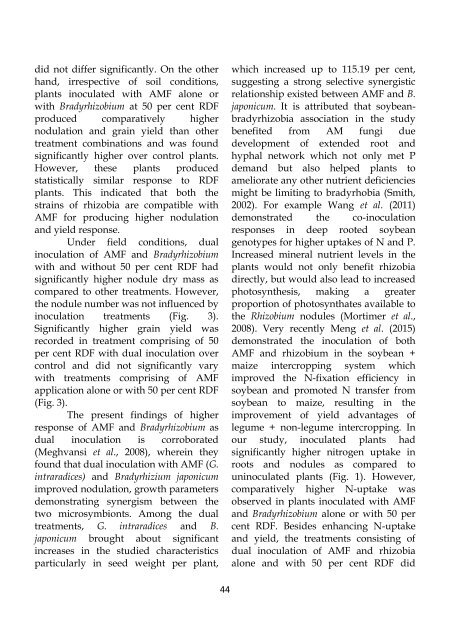SOYBEAN RESEARCH
Soybean-Research-14(2)-2016
Soybean-Research-14(2)-2016
Create successful ePaper yourself
Turn your PDF publications into a flip-book with our unique Google optimized e-Paper software.
did not differ significantly. On the other<br />
hand, irrespective of soil conditions,<br />
plants inoculated with AMF alone or<br />
with Bradyrhizobium at 50 per cent RDF<br />
produced comparatively higher<br />
nodulation and grain yield than other<br />
treatment combinations and was found<br />
significantly higher over control plants.<br />
However, these plants produced<br />
statistically similar response to RDF<br />
plants. This indicated that both the<br />
strains of rhizobia are compatible with<br />
AMF for producing higher nodulation<br />
and yield response.<br />
Under field conditions, dual<br />
inoculation of AMF and Bradyrhizobium<br />
with and without 50 per cent RDF had<br />
significantly higher nodule dry mass as<br />
compared to other treatments. However,<br />
the nodule number was not influenced by<br />
inoculation treatments (Fig. 3).<br />
Significantly higher grain yield was<br />
recorded in treatment comprising of 50<br />
per cent RDF with dual inoculation over<br />
control and did not significantly vary<br />
with treatments comprising of AMF<br />
application alone or with 50 per cent RDF<br />
(Fig. 3).<br />
The present findings of higher<br />
response of AMF and Bradyrhizobium as<br />
dual inoculation is corroborated<br />
(Meghvansi et al., 2008), wherein they<br />
found that dual inoculation with AMF (G.<br />
intraradices) and Bradyrhizium japonicum<br />
improved nodulation, growth parameters<br />
demonstrating synergism between the<br />
two microsymbionts. Among the dual<br />
treatments, G. intraradices and B.<br />
japonicum brought about significant<br />
increases in the studied characteristics<br />
particularly in seed weight per plant,<br />
which increased up to 115.19 per cent,<br />
suggesting a strong selective synergistic<br />
relationship existed between AMF and B.<br />
japonicum. It is attributed that soybeanbradyrhizobia<br />
association in the study<br />
benefited from AM fungi due<br />
development of extended root and<br />
hyphal network which not only met P<br />
demand but also helped plants to<br />
ameliorate any other nutrient deficiencies<br />
might be limiting to bradyrhobia (Smith,<br />
2002). For example Wang et al. (2011)<br />
demonstrated the co-inoculation<br />
responses in deep rooted soybean<br />
genotypes for higher uptakes of N and P.<br />
Increased mineral nutrient levels in the<br />
plants would not only benefit rhizobia<br />
directly, but would also lead to increased<br />
photosynthesis, making a greater<br />
proportion of photosynthates available to<br />
the Rhizobium nodules (Mortimer et al.,<br />
2008). Very recently Meng et al. (2015)<br />
demonstrated the inoculation of both<br />
AMF and rhizobium in the soybean +<br />
maize intercropping system which<br />
improved the N-fixation efficiency in<br />
soybean and promoted N transfer from<br />
soybean to maize, resulting in the<br />
improvement of yield advantages of<br />
legume + non-legume intercropping. In<br />
our study, inoculated plants had<br />
significantly higher nitrogen uptake in<br />
roots and nodules as compared to<br />
uninoculated plants (Fig. 1). However,<br />
comparatively higher N-uptake was<br />
observed in plants inoculated with AMF<br />
and Bradyrhizobium alone or with 50 per<br />
cent RDF. Besides enhancing N-uptake<br />
and yield, the treatments consisting of<br />
dual inoculation of AMF and rhizobia<br />
alone and with 50 per cent RDF did<br />
44


